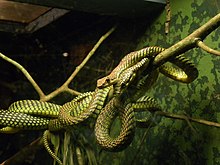Chrysopelea paradisi
| Paradise flying snake | |
|---|---|

| |
| Scientific classification | |
| Kingdom: | Animalia |
| Phylum: | Chordata |
| Class: | Reptilia |
| Order: | Squamata |
| Suborder: | Serpentes |
| Family: | Colubridae |
| Genus: | Chrysopelea |
| Species: | C. paradisi
|
| Binomial name | |
| Chrysopelea paradisi Boie, 1827
| |
Paradise tree snake or paradise flying snake, Chrysopelea paradisi, is a species of snake found in southeastern Asia. It can, like all species of its genus Chrysopelea, glide by stretching the body into a flattened strip using its ribs. It is mostly found in moist forests and can cover a horizontal distance of 10 meters or more[2] in a glide from the top of a tree. Slow motion photography shows an undulation of the snake's body in flight while the head remains relatively stable, suggesting controlled flight. They are mildly venomous with rear fangs and also can constrict their prey, which consists of mostly lizards and bats.
Kinematics[]
Although the flying snake does not display visible characteristics that contribute to its ability to glide, there are three aspects that have been studied and found to have great positive effects on this. Their form of takeoff which is most commonly the anchored J-loop take-off,[3] once airborne their cross sectional body is shaped into a triangle [4] and their bodies use an aerial undulation to maximize the distance traveled.[5]
Distribution[]
Thailand (incl. Phuket), Cambodia, Indonesia (Bangka, Belitung, Java, Mentawai Archipelago, Natuna Archipelago, Nias, Riau Archipelago, Sumatra, We, Borneo, Sulawesi), Brunei Darussalam; India (Andaman Islands), Malaysia (Malaya and East Malaysia); Myanmar (Burma); Philippine Islands (including Sulu Archipelago, Negros Oriental, Siquijor, Panay, Luzon); Singapore; Race celebensis: Indonesia (Sulawesi) ; Bangladesh (Sylhet, Chittagong, Khulna, Race: Golden Flying Snake).
Race variabilis: Philippine Islands (including Sulu Archipelago)
References[]
- ^ Vogel, G.; Wogan, G.; Diesmos, A.C.; Gonzalez, J.C.; Inger, R.F. (2014). "Chrysopelea paradisi". IUCN Red List of Threatened Species. 2014: e.T183189A1732041. Retrieved 3 June 2020.
- ^ "Here's how flying snakes stay aloft". Science News. 2020-06-29. Retrieved 2021-01-14.
- ^ Socha, J. J. (1 September 2006). "Becoming airborne without legs: the kinematics of take-off in a flying snake, Chrysopelea paradisi". Journal of Experimental Biology. 209 (17): 3358–3369. doi:10.1242/jeb.02381. PMID 16916972.
- ^ Holden, D.; Socha, J. J.; Cardwell, N. D.; Vlachos, P. P. (29 January 2014). "Aerodynamics of the flying snake Chrysopelea paradisi: how a bluff body cross-sectional shape contributes to gliding performance". Journal of Experimental Biology. 217 (3): 382–394. doi:10.1242/jeb.090902. PMID 24477611.
- ^ Socha, J. J. (15 May 2005). "A 3-D kinematic analysis of gliding in a flying snake, Chrysopelea paradisi". Journal of Experimental Biology. 208 (10): 1817–1833. doi:10.1242/jeb.01579. PMID 15879063.
- Boie, F. 1827 Bemerkungen über Merrem's Versuch eines Systems der Amphibien, 1. Lieferung: Ophidier. Isis van Oken, Jena, 20: 508–566.
External links[]
 Data related to Chrysopelea paradisi at Wikispecies
Data related to Chrysopelea paradisi at Wikispecies Media related to Chrysopelea paradisi at Wikimedia Commons
Media related to Chrysopelea paradisi at Wikimedia Commons- Chrysopelea paradisi at the Reptarium.cz Reptile Database
- Flying snake home page by Jake Socha
- C. paradisi at Thailand Snakes.
- Flying Snake Video w/additional info.
- Research related article.
- IUCN Red List least concern species
- Colubrids
- Gliding snakes
- Reptiles of Brunei
- Reptiles of Myanmar
- Reptiles of India
- Reptiles of Indonesia
- Reptiles of Malaysia
- Reptiles of the Philippines
- Reptiles of Singapore
- Reptiles of Thailand
- Fauna of Borneo
- Reptiles described in 1827
- Colubrid stubs

